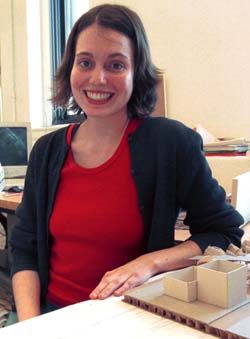Buildings, in their construction, maintenance and operation, account for nearly half the energy consumed by developed countries. Many architects, particularly young architects, see a pressing need for more environmentally responsible architecture, an architecture that safeguards fraying links to the natural world.

As co-founder of the student group Green Givens, the School of Architecture’s Erin O’Mahoney Cubbison has helped foster a groundswell of campus interest in sustainable design. Over the past two years, Green Givens has organized well-attended lectures and discussions, co-sponsored the St. Louis stop of the national touring exhibition Ten Shades of Green, and launched what will hopefully become an annual series of events known as Green Givens Week.
“We can all agree that sustainability is a good thing; the question is how to accomplish it,” says Cubbison, who in addition to her architecture degree has earned a minor in Environmental Studies in Arts & Sciences. “Just talking about green design isn’t enough.
“Architects want to see what it looks like — specific, real-world examples of how you incorporate these principles into actual projects.”
Yet Cubbison’s accomplishments are not merely organizational. Fluent in Spanish, she has twice traveled to Central America — as a freshman, to help build a bridge in rural El Salvador, and as a sophomore, to conduct field research on crop diversity with University biologist Allison Miller.
Last fall, she was one of five students who took part in a study-abroad program in Copenhagen, Denmark, where she studied the relationship between Scandinavian architecture and ecology.
“You have to elevate your teaching when you teach to Erin,” says Gay Lorberbaum, affiliate associate professor of architecture, who recently coordinated an independent-study project on sustainability issues, in which Cubbison took part. “There’s not a lazy bone in her body.
“She’s tenacious, responsible, self-reliant and unassuming, though she stands out in her quiet way. She’s courageous in the way that you have to be courageous if you’re going to change the world.”
| School of Architecture |
Last year, as part of a studio led by Professor Carl Safe, Cubbison and a group of classmates designed and ultimately constructed a climate-sensitive pavilion in the 6600 block of Delmar Boulevard in University City. The airy, trellis-like structure, built of cedar and steel, is topped by a series of louvers that maximize shade during the height of summer but allow light to permeate in winter, when the sun passes lower in the southern sky.
“We set the louvers at 65 degrees, because it turns out that people start wanting shade around April, when the sun is about 65 degrees off the horizon,” Cubbison explains. “It’s not a difficult principle; it’s just a matter of deciding to use it.”
This past semester, Cubbison spent long, extracurricular hours working with alumna Emily Lamert to design a central “common house” for residents of Dancing Rabbit, an “eco-village” located near Rutledge, Mo.
“They’re the perfect clients,” Cubbison says with a laugh. “They don’t take power off the grid, they grow most of their own food, they collect rainwater for cooking and showers. We don’t have to convince them that sustainability is important.”
Like Dancing Rabbit’s existing buildings, the common house will employ straw-bale construction, a low-cost, highly insulating technique in which straw walls are reinforced with steel rebar and sealed with clay or plaster finishes.
A pitched roof maximizes winter sun and summer shade; interior doors “air-lock” entranceways; windows, concentrated on the eastern and southern sides, avoid chill northern winds and hot western glare. Runoff from sinks, showers and washing machines is naturally purified and reused, while the entire building is set partially below grade, tapping the Earth’s thermal mass.
After Commencement, Cubbison plans to return to her native Pittsburgh and spend at least two years working in professional practice, perhaps as an environmental consultant, before possibly returning to school for a postgraduate degree. In the meantime, she plans to earn LEED (Leadership in Energy and Environmental Design) accreditation, a recently established national standard for assessing and promoting sustainability in buildings.
“If I do pursue architecture as a profession, I’d like to have a strong background in the specific, scientific methods of incorporating environmental design,” she explains. “I want to be able to focus on the issues and the kinds of design I feel passionate about.”